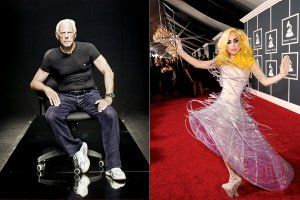
After winning two Grammy Awards last year and swanning down the red carpet like a celestial debutante with her own orbiting moons, Lady Gaga is now up for album of the year for The Fame Monster. One can only assume—hope, pray—she will arrive at the Staples Center in Los Angeles wearing a costume more marvelously atrocious than anything even her most ardent fans, the little monsters, could fathom.
Stefani Joanne Angelina Germanotta, 24, steamrolled into the popular consciousness with accessible pop beats, an outré public persona, and a well-crafted personal history founded on the irresistible fable of the misunderstood outcast who now finds herself with more than 10 million Facebook friends. No matter how much one adores her songs or despises their ubiquity, it's impossible to separate her musical success from her fashion—a manner of dress that blurs the line between costume and couture. Her sensibility is too self-consciously considered to be madcap stagecraft. Yet it doesn't have the kind of eloquence that exemplifies French couture. It is, in essence, couture kitsch.
Gaga's relationship with the fashion industry is, as one might imagine, complicated. It is symbiotic, exploitative, audacious, and, at times, embarrassing. In the past, when fashion designers have glommed on to a new star, they have bent her to their will. If she is fat, she soon loses weight. If her hair is a jungle of curls, it's quickly flat-ironed. If her taste is too down-market, she swiftly goes upscale. The poor dear doesn't stand a chance when set upon by an industry of self-appointed Pygmalions.
This time, however, Gaga is calling the shots.
She reinvigorated Giorgio Armani, the veteran Italian designer who has often felt stifled by his own success. American Gigolo, Oscars, power suits. Gaga set him free. When her hoop-skirted, crystal-studded extravaganza appeared on the red carpet last year, Armani's staff sent an email across the fashion world identifying it as the work of the ever-discreet designer. One could only respond with "Holy bedazzlement!"
The experience left the septuagenarian designer sounding positively gob-smacked. "True creativity knows no bounds," he enthuses. "Life has an extra dimension made up of dreams, pleasure, and irony." Little monsters, please discuss and, if you can, tell us what that means.
Gaga's personal daring opened doors for her collaborator Nicola Formichetti—the stylist and fashion editor responsible for the meat frock she wore at the MTV Video Music Awards last fall. Formichetti now serves as the creative director of Thierry Mugler and is charged with raising the French brand from its moribund state. He's doing so based on what might be described as the Gaga doctrine.
"The way I work with Gaga is to be free and creative and to do something new," Formichetti says. "The starting point is always to be art, fashion, music, and performance art. That's how I deal with all my projects. And that's how I started with Mugler … the Internet, digital communications, and marketing the clothing is as important as designing the clothing.
"I'm not an elitist," Formichetti says. "I want everyone to share what we're about."
And Gaga is not some high-strung fashion icon. She isn't setting a standard of dress for the masses. She has donned a coat stitched out of Kermits, worn dominatrix gear to a nursing home, and walked down the street in little more than her underpants. Fans might doll up for her concerts in wigs and colorful makeup, but Gaga hasn't popularized any major trends—and for folks with a sensitive stomach or a quaint devotion to propriety, this is probably for the best. Instead, she is the video vixen next door, a fashion shoot come to your street corner, performance art in your living room.
She was spawned by an entertainment industry that produced Madonna, David Bowie, and Grace Jones, who built stage personas that toyed with prescribed gender roles, sexual prohibitions, and social power. They might not have been wholly intellectual in their costuming, but their message was multilayered. (Jones in a gorilla suit is an image rich enough to engage a battalion of sociologists for a lifetime.) Gaga hasn't expanded that conversation; instead, she luxuriates in the space carved out long ago.
As trends come and go, an icon holds fast. Gaga is a chameleon, a tortured soul searching for her identity through outrageous fashion. She may not have defined herself, but neither has some designer.
Her style represents "liberation," says Mathieu Deflem, a sociology professor at the University of South Carolina who teaches "Lady Gaga and the Sociology of the Fame." (If Gaga won't remain static long enough to be dissected, then we will dissect ourselves dissecting her.)
She has been like a turbocharger for a fashion industry stuck in first gear ever since the global recession hit, the minimalist sensibility of Céline's Phoebe Philo took hold, and the size of the models on the runway became more controversial than what they were wearing.
Armani, the unlikeliest designer to be jolted by Gaga juice, discovered her in the most mundane way: he saw her perform at the American Music Awards a little more than a year ago. "I was struck by her extraordinary talent for writing music and her mastery of her own voice," the designer says. And he was enamored by how she'd "deliberately created a totally outlandish personality."
Most celebrities come to Armani seeking salvation from their tasteless ways. But Gaga did not genuflect. She inspired the designer to craft a brilliant silver minidress with a lightning-bolt head ornament. He made a black leather bodysuit for her "Alejandro" video. He stocked a wardrobe trunk for her current tour. She even induced him to create a green spangled leotard with shoulders like Mickey Mouse ears. Armani was clearly intoxicated by Gaga. And that last look was the fashion equivalent of drunk dialing.
"No other artist would give me the opportunity to devise such original and way-out creations," Armani explains. "Lady Gaga's costumes are a pure creativity exercise that allows me to design spectacular, almost surreal pieces."
While Gaga allowed Armani to break out of his gilded cage, she helped Formichetti step into fashion's center ring. He debuted his menswear collection in January and will show the women's next month. Gaga wasn't in the audience, but she was on the musical soundtrack, and her influence was evident in the opening video. It starred model Rick "Rico" Genest, who is tattooed to look like a skeleton in full-blown Halloween gore.
Formichetti plans to build on the legacy of the house, which is known for strong silhouettes and a larger-than-life sensibility. (See George Michael's 1992 video for "Too Funky.") "By wearing Mugler, you felt more powerful," Formichetti says. "It almost had a superhuman aspect to it. What I want to continue to do is … not only great powerful clothing, but also mixing music, subcultures, more of an entertainment spirit."
The resulting clothes were dramatic and brooding. It would be excessive to attribute those characteristics solely to Gaga. But Formichetti's belief that there's a place for costume drama in modern life, that comfort isn't always paramount, and that attracting wide-eyed stares on the street is an admirable goal—that's pure Gaga.
"She took what I was doing in magazines, on models, and actually started wearing it," Formichetti says. She brought his photo shoots to life, and "it was a high for me."
As a result, Formichetti says, "I don't want to just do a very standard, mass-produced collection."
He wants to do Gaga, which in fashion-speak now means going creatively, boldly, and happily crazy.
Uncommon Knowledge
Newsweek is committed to challenging conventional wisdom and finding connections in the search for common ground.
Newsweek is committed to challenging conventional wisdom and finding connections in the search for common ground.
About the writer
To read how Newsweek uses AI as a newsroom tool, Click here.








